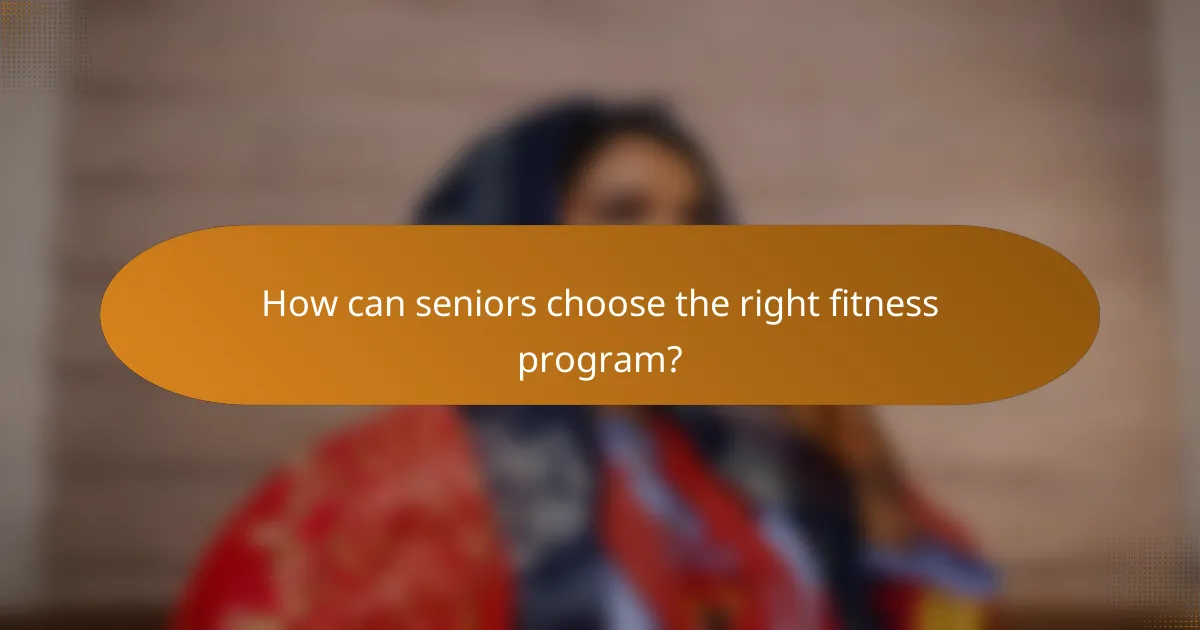Senior fitness programs are designed to enhance the physical health and social engagement of older adults, focusing on safe and enjoyable exercises tailored to their unique needs. By prioritizing low-impact activities, these programs help minimize injury risks while fostering a sense of community and motivation among participants. With the support of knowledgeable instructors, seniors can improve their overall well-being and maintain an active lifestyle.

What are effective senior fitness programs in the United States?
Effective senior fitness programs in the United States focus on enhancing physical health, social engagement, and overall well-being. These programs cater to various fitness levels and often include specialized classes designed for older adults to promote safety and enjoyment.
SilverSneakers program
The SilverSneakers program is a popular fitness initiative that provides seniors with access to gym facilities, fitness classes, and wellness resources. Participants can join a variety of classes, such as yoga, strength training, and aerobics, specifically tailored for older adults.
This program is often included in Medicare Advantage plans, making it accessible for many seniors at little to no cost. It emphasizes social interaction, encouraging members to connect with peers while improving their fitness levels.
YMCA senior fitness classes
YMCA senior fitness classes offer a range of activities designed to meet the needs of older adults, focusing on strength, flexibility, and cardiovascular health. Classes may include water aerobics, chair yoga, and low-impact aerobics, all aimed at enhancing mobility and reducing injury risk.
Membership at the YMCA often provides access to additional resources, such as health screenings and wellness programs, fostering a supportive community for seniors. Many YMCAs offer financial assistance to ensure affordability for all participants.
Active Aging programs
Active Aging programs are designed to promote physical activity among older adults through various engaging activities. These programs typically include walking groups, dance classes, and fitness workshops that focus on maintaining independence and enhancing quality of life.
Participants are encouraged to set personal fitness goals and track their progress, which can lead to improved motivation and adherence to a regular exercise routine. Many Active Aging programs also emphasize the importance of social connections, providing opportunities for seniors to meet and engage with others.
Local community center offerings
Local community centers often provide a variety of fitness programs tailored for seniors, including group exercise classes, swimming sessions, and wellness seminars. These offerings are typically affordable and designed to accommodate different fitness levels and interests.
Community centers may also host special events or workshops focused on health education, nutrition, and active living, fostering a sense of community among participants. Checking with local centers for schedules and membership options can help seniors find suitable programs nearby.

How do senior fitness programs address health considerations?
Senior fitness programs prioritize health considerations by focusing on safe, effective exercises tailored to the needs of older adults. These programs often emphasize low-impact activities that enhance physical well-being while minimizing injury risks.
Focus on low-impact exercises
Low-impact exercises are essential in senior fitness programs as they reduce stress on joints while still providing cardiovascular and strength benefits. Activities such as walking, swimming, and cycling are commonly included, allowing seniors to engage in physical activity without excessive strain.
Instructors often recommend starting with sessions of 20-30 minutes, gradually increasing duration and intensity as fitness levels improve. This approach helps build endurance while maintaining safety.
Importance of flexibility and balance
Flexibility and balance are critical components of senior fitness programs, as they help prevent falls and enhance overall mobility. Stretching exercises, yoga, and tai chi are frequently incorporated to improve range of motion and stability.
Regular practice of these activities can lead to significant improvements in daily functioning, allowing seniors to perform everyday tasks with greater ease. Aim for flexibility and balance training at least two to three times a week for optimal results.
Monitoring chronic conditions
Monitoring chronic conditions is vital in senior fitness programs to ensure participants engage in safe and appropriate exercises. Conditions such as arthritis, diabetes, and heart disease require tailored approaches that consider individual health statuses.
Instructors should work closely with healthcare providers to develop exercise plans that accommodate these conditions. Regular check-ins and adjustments to the program can help manage symptoms effectively and promote long-term health benefits.

What social aspects are important in senior fitness programs?
Social aspects in senior fitness programs are crucial for enhancing motivation and promoting overall well-being. Engaging with others through fitness activities can lead to improved mental health, increased adherence to exercise routines, and the development of a supportive community.
Group classes for social interaction
Group classes provide an excellent opportunity for seniors to engage socially while staying active. These classes often include activities like yoga, aerobics, or dance, which not only promote physical health but also foster camaraderie among participants. Regular attendance can help seniors form connections, making exercise a more enjoyable and less isolating experience.
When selecting a group class, consider the class size and the instructor’s approach to fostering interaction. Smaller classes may allow for more personalized attention, while larger classes can create a vibrant community atmosphere.
Community events and activities
Community events, such as fitness fairs or charity walks, encourage seniors to participate in physical activities while connecting with others. These events often feature a variety of activities, from walking groups to health screenings, allowing seniors to choose what suits them best. Participating in such events can enhance a sense of belonging and purpose.
Look for local community centers or senior organizations that host regular events. Engaging in these activities can help seniors stay active and meet new friends in their area.
Building friendships through fitness
Building friendships through fitness is a natural outcome of participating in group activities. As seniors work out together, they share experiences and support each other, which can lead to lasting friendships. This social support is vital for maintaining motivation and accountability in fitness routines.
Encourage seniors to exchange contact information with classmates or to plan post-workout gatherings, such as coffee or lunch. These interactions can strengthen bonds and create a supportive network that extends beyond the fitness class.

What role do instructors play in senior fitness?
Instructors play a crucial role in senior fitness by providing guidance, support, and tailored programs that cater to the unique needs of older adults. Their expertise helps ensure safe and effective exercise practices, fostering both physical health and social engagement.
Qualifications for senior fitness instructors
Senior fitness instructors typically hold certifications that demonstrate their knowledge of age-related health issues and exercise techniques. Common qualifications include certifications from organizations like the American Council on Exercise (ACE) or the National Academy of Sports Medicine (NASM), which focus on senior fitness principles.
Instructors should also have experience working with older adults, understanding their specific physical limitations and health concerns. This background enables them to create safe and effective workout plans tailored to individual needs.
Personalized fitness plans
Creating personalized fitness plans is essential for addressing the diverse abilities and health conditions of seniors. Instructors assess each participant’s fitness level, medical history, and personal goals to design a program that promotes improvement while minimizing injury risks.
These plans may include a mix of cardiovascular exercises, strength training, flexibility routines, and balance activities. Regular assessments help instructors adjust the plans as needed, ensuring continued progress and engagement.
Support and motivation
Instructors provide ongoing support and motivation, which are vital for maintaining participation in fitness programs. They encourage seniors to set realistic goals and celebrate achievements, fostering a positive environment that promotes adherence to exercise routines.
Group classes can enhance social interaction, making fitness more enjoyable. Instructors often facilitate camaraderie among participants, which can lead to lasting friendships and a supportive community that encourages regular attendance.

How can seniors choose the right fitness program?
Seniors can choose the right fitness program by assessing their personal fitness goals, evaluating accessibility, and considering social opportunities. These factors ensure that the program aligns with their health needs and lifestyle preferences.
Assessing personal fitness goals
Identifying personal fitness goals is crucial for seniors when selecting a program. Goals may include improving strength, enhancing flexibility, or increasing cardiovascular health. Setting specific and realistic objectives helps in choosing a program that meets individual needs.
Seniors should consider their current fitness level and any medical conditions. For example, someone recovering from an injury may prioritize rehabilitation exercises, while another senior may focus on maintaining mobility and balance.
Evaluating program accessibility
Accessibility is a key factor in choosing a fitness program. Seniors should look for programs that are conveniently located and offer transportation options if needed. Online classes can also provide flexibility for those who prefer to exercise at home.
Additionally, it’s important to assess the physical environment of the program. Facilities should be senior-friendly, with appropriate equipment and safety measures in place. Programs that cater to varying levels of mobility can enhance participation.
Considering social opportunities
Social interaction is an important aspect of fitness programs for seniors. Many programs offer group classes, which can foster a sense of community and encourage regular attendance. Engaging with peers can enhance motivation and enjoyment.
When evaluating options, seniors should look for programs that incorporate social activities, such as group outings or events. These opportunities can lead to lasting friendships and a more fulfilling fitness experience.

What are the costs associated with senior fitness programs?
The costs of senior fitness programs can vary significantly based on location, type of program, and facility. Generally, seniors can expect to pay for membership fees, class costs, and any additional services offered by fitness centers.
Membership fees for local gyms
Membership fees for local gyms typically range from around $20 to $60 per month for seniors, depending on the amenities and services provided. Some gyms offer discounted rates for seniors, while others may have special promotions or community programs that reduce costs.
When considering a gym membership, evaluate what is included in the fee. Look for facilities that offer senior-specific classes, access to trainers knowledgeable about senior fitness, and additional perks like swimming pools or group activities.
It’s also wise to inquire about any initiation fees or annual contracts that may affect the overall cost. Many gyms provide trial periods, allowing seniors to test the facilities before committing to a long-term membership.



